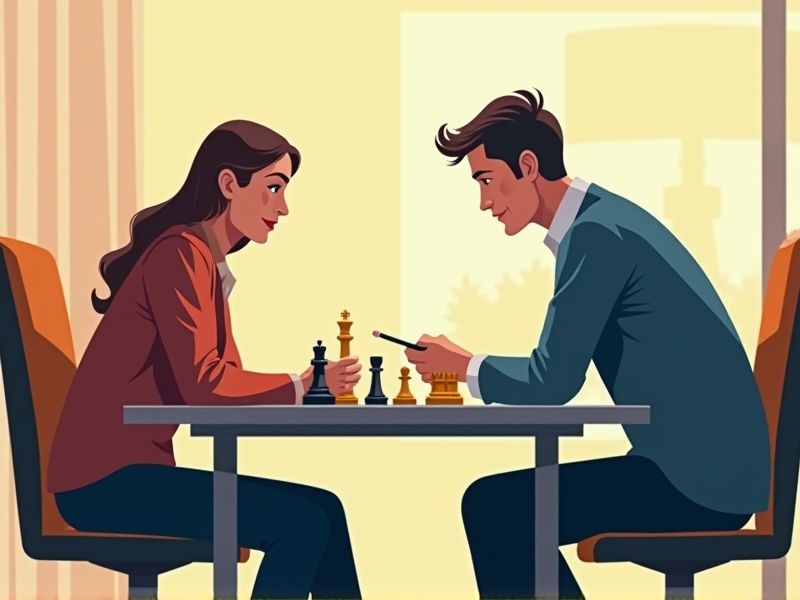
Emanuel Lasker's advice to "look for a better move" when you see a good one can be adapted to bullet chess by focusing on quick, adequate moves rather than perfect ones. In bullet chess, players should prioritize speed and intuition over deep calculation, making moves that are likely to be good enough rather than optimal. This approach allows players to conserve time and exploit their opponents' mistakes, as the fast-paced nature of bullet chess often leads to blunders. By combining Lasker's strategic mindset with the tactical urgency of bullet chess, players can improve their chances of winning by leveraging their opponent's time pressure.
How to Be Better at Bullet Chess
Optimize pre-moves.
Optimizing pre-moves in bullet chess starts with anticipating your opponent's responses through pattern recognition and deep opening preparation. By developing strong board visualization skills, you reduce the friction between decision-making and execution, making your pre-moves more precise. Repeated practice in varied positions helps reinforce muscle memory, so your responses become nearly instinctual under time pressure. Regularly reviewing your games to identify pre-move mistakes can lead to measured improvements in speed and accuracy during critical moments.
Enhance pattern recognition.
Study rapid-fire tactical puzzles daily to train your brain in recognizing recurring motifs. Focus on reviewing bullet games--both your own and those of top players--to see how common patterns unfold in real situations. Emphasize speed over perfection during practice sessions, building up the instinct to spot key formations quickly. Maintain a practice log, tracking recognized patterns and their outcomes to deepen your pattern recognition over time.
Simplify openings.
Bullet chess demands fast, reliable decisions, and having a streamlined opening repertoire is key. Focus on a couple of simplified openings that avoid complex theory and allow for rapid piece development. This approach minimizes mistakes under time pressure while keeping your position solid. By reducing early-game complexity, you can save precious seconds for the tactical middlegame and endgame.
Cultivate intuitive responses.
Bullet chess demands rapid decision-making where quick, instinctive moves are key. Cultivating intuitive responses involves regularly practicing pattern recognition so that familiar tactical motifs are instantly recalled. This approach reduces analysis time while increasing the likelihood of making effective moves under tight time constraints. As a result, refining your intuition directly enhances overall performance, allowing you to capitalize on opportunities while minimizing errors in fast-paced games.
Master tactical motifs.
Bullet chess is a fast-paced format where every second counts, and mastering tactical motifs can boost your efficiency significantly. Recognizing patterns like forks, pins, skewers, and discovered attacks enables you to convert fleeting opportunities into tangible advantages. When you internalize these motifs, your decision-making accelerates, reducing the likelihood of costly missteps under time pressure. Regular practice with tactical puzzles and rapid-fire drills helps ingrain these patterns, leading to a measurable improvement in your win rate.
Sharpen time management.
Bullet chess demands a fine balance between speed and precision, so every second counts. Sharpen time management by practicing rapid decision-making drills and timed puzzles to condition your brain to evaluate moves under pressure. Focus on recognizing recurring patterns and positions, which allows you to bypass prolonged analysis and plays to pre-learned strategies. Analyze your games afterward, identifying moments where careful time allocation could have reduced mistakes, thus optimizing overall performance.
Streamline decision-making.
Focus on familiar openings that have preset lines, which minimizes the time spent deciding on each move. Quick instinctual evaluations allow you to capitalize on opponent mistakes before they have time to recover. Rely on pattern recognition and simplify complex positions to avoid time-consuming analysis. Continuous practice under time constraints enhances automatic responses, yielding a more streamlined decision-making process.
Strengthen endgame awareness.
Bullet chess rewards players who can navigate tight situations with precise, instinctive moves, and honing your endgame awareness is crucial to achieve this. Enhancing your understanding of key endgame positions helps you save time and avoid blunders when the clock is ticking down. Regular practice of common endgame scenarios trains you to quickly recognize winning patterns and counter your opponent's strategies. Emphasizing endgame drills and studying theoretical positions will strengthen your decision-making, ultimately boosting your performance in fast-paced bullet games.
Integrate rapid analysis.
Integrate rapid analysis into your decision-making process by practicing quick pattern recognition during games. Sharpen your ability to evaluate positions in fractions of a second through timed puzzles and real-time feedback tools. Develop an instinct for key tactical motifs by reviewing bullet game replays in a focused, data-driven manner after each match. Enhance your performance by incorporating both strategic foresight and immediate tactical assessment into every move.
Emphasize focused practice.
Focused practice builds the foundation for improved decision-making under pressure, reinforcing both speed and accuracy. Concentrated drills enhance pattern recognition and calculation, which translates directly into better move selection during intense bullet matches. Regular training in simulated high-pressure scenarios conditions the mind to process complex positions rapidly. This structured, data-driven approach leads to measurable gains, making focused practice a key driver in bullet chess success.
Summary
Optimizing pre-moves sharpens play by minimizing decision time on the clock, directly boosting efficiency in critical moments. Enhancing pattern recognition accelerates the identification of tactical opportunities and threats, ensuring quick and effective responses. Simplified openings reduce the cognitive load early in the game, allowing for smoother transitions into mid- and endgame strategies. These focused improvements create a cohesive framework that significantly elevates overall bullet chess performance under time pressure.
